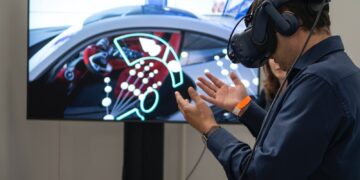Augmented reality (AR) and virtual reality (VR) are becoming more popular across industries. AR integrates digital elements into the physical world, while VR is a simulated experience where people immerse themselves in a virtual world. The AR and VR market is set to reach $114.5 billion by 2027 due to its increased application in several industries, including healthcare and retail.
The photography industry isn’t too far behind, as it is exploring the potential applications of these technologies. If you want to know what these applications are and how to utilize them, keep reading below.
Make photo products more immersive
Photos are one-dimensional, providing a single perspective for the viewer. While this is the nature of photographs, AR can make them more immersive. Photographers can create 360 images and allow people to view them on AR apps, making them feel like they’re part of the scene.
You can do this with a 360 camera, which is one of the latest digital camera innovations. This camera has two or more lenses to capture 360-degree photos and videos. A famous example is the Insta 360 One R, which features a 5.7k resolution to ensure every pixel is clear. One way to use this is in immersive wedding albums. You can take a 360 photo of a couple’s first dance, include it in the album, and allow them to scan the photo with a VR app. With this, they’ll have a 360 view of the venue to see guests’ reactions.
Sell photos more effectively
Photographers may find it difficult to sell their photos, especially online. This is because buyers cannot visualize if a print suits their space. Thankfully, AR can address this dilemma.
Photographers can utilize AR as an art visualization tool to help buyers see how a photo would look once hung on their wall. Using a smartphone camera, they can virtually position a framed picture in their home or office. This helps them see if it matches their wall color, furniture, and decor, which helps convince them to purchase. Art Storefronts offers this service to help photographers sell their work more effectively.
Improve photography skills
Being in a creative career, photographers are continuously learning. There are constantly emerging photography techniques or editing skills that they can use to improve their craft. Besides reading books or watching tutorials, photographers can sharpen their skills using VR technology. After all, our article discussing XR technology —encompassing VR— notes how it is used to upskill employees by immersing them in the learning experience.
The VR painting app Tilt Brush enables users to paint in a virtual space. Photographer Eric Kim’s 2020 article “How VR Can Help You Become A Better Photographer” notes how this allows photographers to view photos from different angles to learn more about their composition, depth, and layers. As such, they improve their composition and framing skills.
Hold engaging virtual photo exhibitions
Photographers who want to expand their works’ reach can use VR to hold virtual photo exhibitions. This way, people from all over the world can view their work.
Many 360 VR photo gallery programs can be used to host the exhibit, such as STYLY. Photographers can simply upload their work on the platform for everyone to see. To provide a better experience, they should recommend that their viewers use a high-resolution VR headset, such as the HTC VIVE Pro 2. This headset delivers a 2.5k resolution to each eye, and it features real RGB sub-pixels, letting people appreciate their photos’ details.
AR and VR are becoming more prominent in the photography industry. Hopefully, with the points we’ve discussed, you can take advantage of these technologies to improve your craft.










































